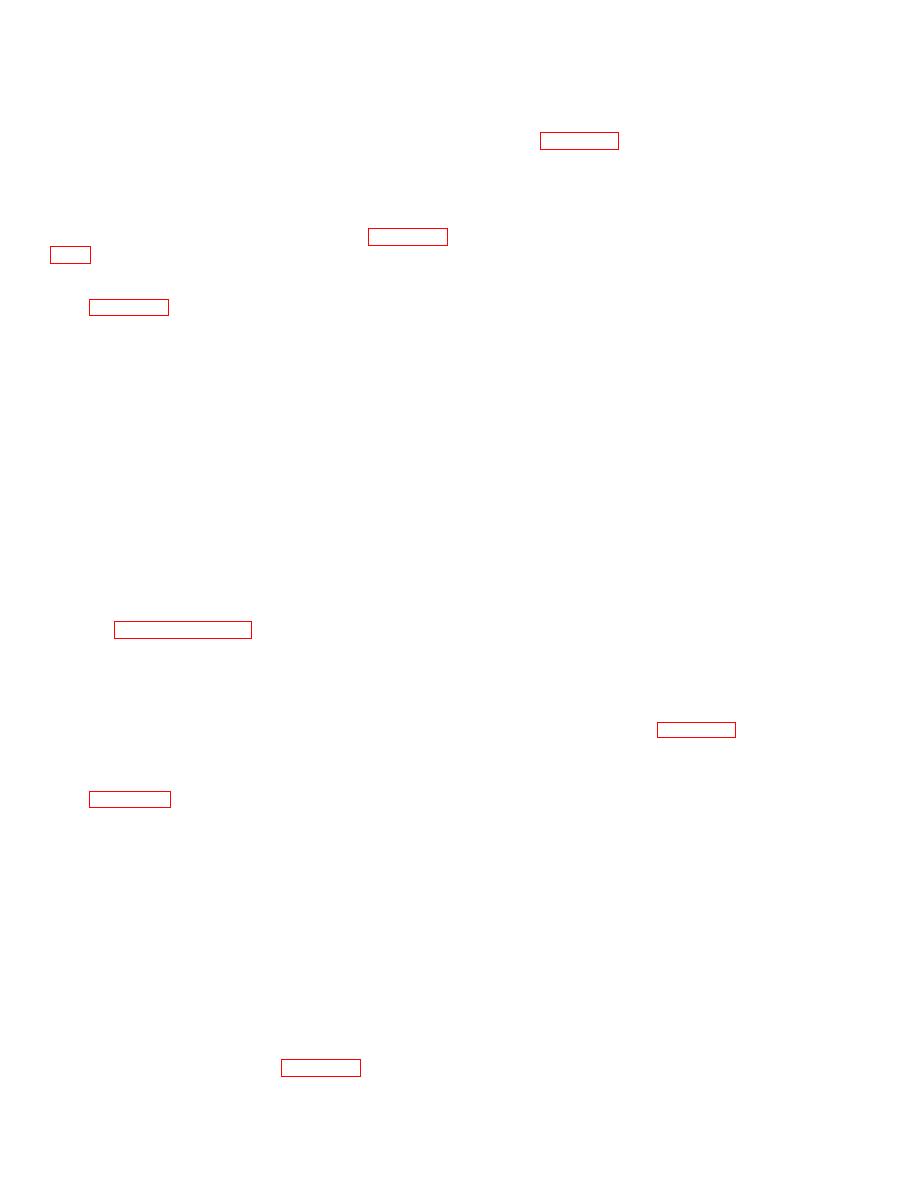
assembly from its mounting port and slip the tube fitting
c. Screw fitting into mounting hole until tube fitting
gasket (5-5, 12) from the threaded end of the valve body.
gasket located between two sets of threads contacts edge
of hole. Screw fitting into mounting hole an additional 1-
4.8.2 DISASSEMBLY. To disassemble the pressure relief
1/2 turns.
valve (see Figure 5-5):
a. Cut safety wire and remove wire and lead seal.
d. Position fitting as required and tighten fitting nut
Unscrew adjusting screw (2) and stem (3) from body (11).
against mounting surface with a torque of 100 pound
inches.
b. Remove spring (4), shims (5), spring retainer (6)
4.5.8 INSTALLATION. To install the instrument panel
and piston assembly (7) from body (11).
assembly, perform the removal procedure (paragraph
NOTE
Do
not
disassemble
piston
4.6 PNEUMATIC LINES AND FITTINGS
assembly (7).
The parts are
installed and crimped within the
4.6.1 Figure 5-3 illustrates the arrangement and location
retainer and cannot be removed
of all inter component connecting tubes, fittings and other
without destroying the assembly.
pneumatic system components and provides the basic
information required for removing and replacing these
d. Remove metal ball (8), ball return spring (9) and
items. Carefully note the location of all clamps and the
packing O-ring from body (11).
exact arrangement of all tubing before removing any
4.8.3 CLEANING AND INSPECTING PARTS. After the
pneumatic lines so that the original equipment
pressure relief valve is disassembled:
configuration can be restored during installation. After
removal, carefully inspect all connecting tubes and fittings
a. Wash all parts with dry-cleaning solvent (Federal
for worn or damaged threads, cracks, dents, distortion and
Specification P-S-661) and dry thoroughly with clean, lint-
other defects that would impair the function of the parts.
free cloths. Use filtered, compressed air to blow solvent
Pay particular attention to the flared ends of connecting
and residue from all crevices, springs and air passages.
tube assemblies since cracking is most apt to occur at the
b. Inspect parts for damaged screw threads, cracks,
root of the flare. Do not attempt to reclaim damaged
breaks or worn areas in anodized surfaces, and other
connecting tubes or other high pressure pneumatic fittings
obvious indications of wear, damage and deterioration.
by repairing or replacing component parts.
c. Inspect finished surfaces of body, stem, adjusting
NOTE
screw and metal ball for scoring, scratches, nicks and
Refer to the procedural steps in
signs of wear.
bulkhead type fittings.
Refer to
d. Do not attempt to repair damaged or questionable
subsequent paragraphs for specific
parts. Discard all such items and install new parts during
instructions covering the removal,
reassembly.
disassembly, and reassembly of
4.8.4 REASSEMBLY. Reassembly is essentially the
component assemblies used in the
reverse of disassembly (see Figure 5-5).
pneumatic system.
a. Apply a thin film of pneumatic system grease
(Specification MIL-L-4343) to new O-ring packing (10),
4.7 FUEL LINES AND TANK
packing groove in body (11), and mating surfaces of body
4.7.1 Figure 5-4 provides the basic information required
and piston assembly (7).
for removing the fuel tank, fuel lines, and other
b. Insert O-ring packing (10) in groove in bore of
component parts of the engine fuel system. Observe
body (11). Install ball return spring (9) and metal ball (8)
approved automotive procedures when removing all fuel
in bore of body.
lines and fittings. Always use new compression sleeves
on flare less tubes. Make sure all connections are tight
c. Install piston assembly (7) in body (11) and down
and leak-proof, and that all tubing is securely clamped to
over metal ball (8) and spring (9).
frame members as in the original equipment configuration.
d. Insert spring retainer (6), cupped side against
Discard all worn, damaged, and questionable parts, and
piston assembly (7).
install new items as required.
e. Place shims (5) and spring (4) in body (11).
4.8 PRESSURE RELIEF VALVE ASSEMBLY 4.8.1
Screw adjusting screw (2) into body. Screw stem (3) into
REMOVAL. Two pressure relief valves are used in the
adjusting screw.
compressor package assembly. One valve is installed in
the cap of the filter and separator assembly (see Figure 1-
4.8.5 TEST AND ADJUSTMENT. Test and adjust the
3); the other valve is mounted in a tee fitting installed at
reassembled pressure relief valve as follows:
the inlet of the air receiver (see Figure 1-4). To remove
either pressure relief valve, simply unscrew the complete
29


